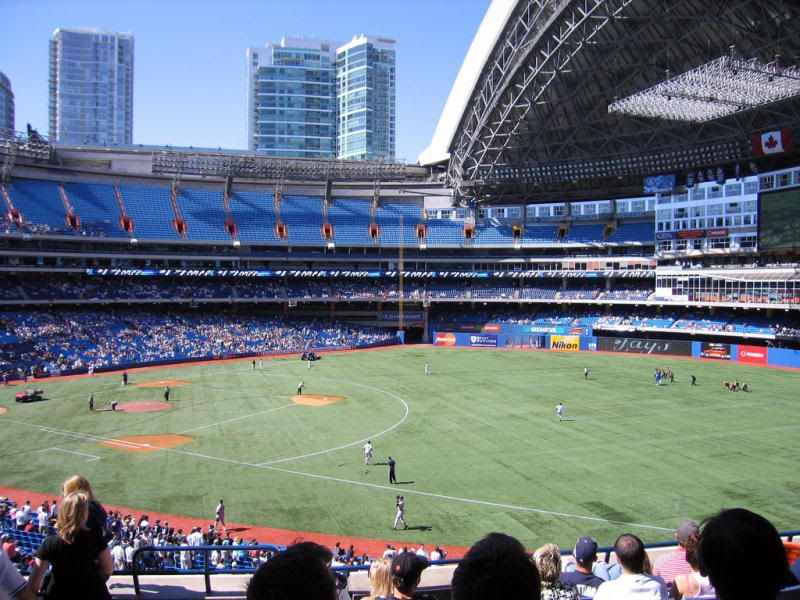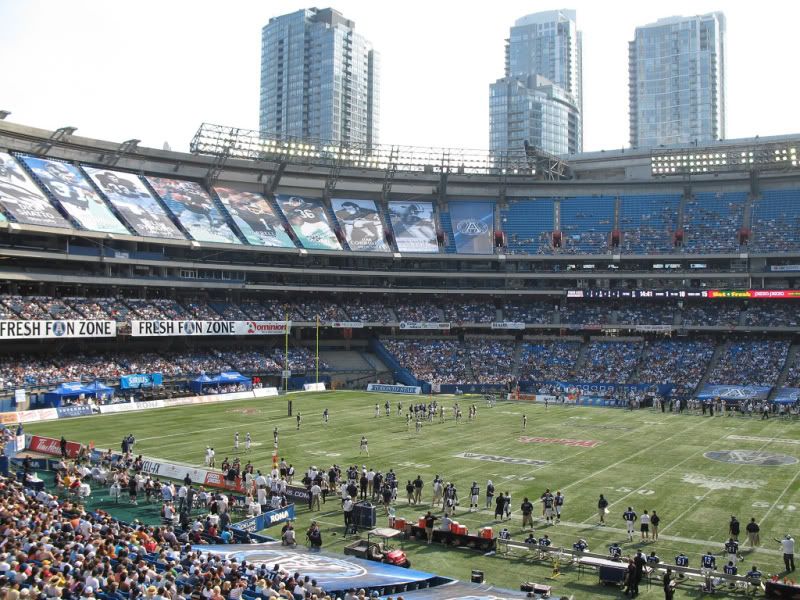I think I disagree with some of your premises,
Baba. For one thing, I'm not sure I would even consider Skydome a "cookie cutter stadium." I had thought that that term referred to a bunch of multipurpose stadiums that were built around the same time (the early 1970s) and
looked very much the same; they were even all round as if they were cookies made from the same cutter. I'm thinking of Three Rivers Stadium in Pittsburgh, Riverfront Stadium in Cincinnati, Busch Stadium II in St. Louis before it was renovated, Veterans Stadium in Philadelphia, and probably some others I'm forgetting "Concrete doughnuts" and "giant ashtrays" are other loving names given to these stadiums.
I don't think the fact that football and baseball are both played in the same stadium is enough by itself to make a stadium a "cookie cutter." The Skydome in Toronto is from a significantly later era, having opened in 1989. It's also set apart by being the first stadium with a working retractable roof. (I'm sure it's not as nice as the newer ones, but that usually comes with being the first.)
Anyway, that's how I was used to thinking of the term "cookie cutter stadium." Maybe I'm off-base there.
Also, I'd like to defend the noble cookie cutter stadium from some of the scorn you're dumping on it.

You say that "Trying to build one stadium for both sports (baseball and football) is inefficient and unworkable." I understand that that's the view of most now, but it wasn't always so. The multi-purpose stadium was a logical step in the development of sports venues.
At first, baseball was America's pastime, and pro football was little more than a sideshow. It could be played wherever there was a flat surface, and baseball fields would do fine, because, more often than not, the crowds weren't big enough to force people to sit where they couldn't see the game.
But football steadily gained popularity, and when baseball stadiums like Forbes or Crosley started wearing out after 50 years or so of use, cities started giving thought to building stadiums that would be suited (as much as possible) for the viewing of both sports. The only alternative would have been to build two stadiums at once-- and while that's what cities do now (Pittsburgh and Cincinnati both did), I don't think it would have worked financially in the 1970s.
Arguably, they had their priorities more in order then. Now, some owners feel entitled to demand that taxpayers fund a costly new building or renovation of an existing facility just over 10 years after it was last renovated-- and take the team elsewhere if the city doesn't buckle to his demands. This is what is happening right now in the NBA to the Seattle Supersonics.
Speaking as someone from Pittsburgh, I am happy that the city built Heinz Field and PNC Park, so we can finally have a beautiful baseball stadium again. (I don't think a football stadium needs to be pretty, but a new one is nice.) I sincerely hope that the Pirates and Steelers get their full use out of those buildings for at least another 30 years and don't try to pull what the NBA is letting the owner of the Sonics get away with.
But I'm also glad for the 30 years of use we got out of Three Rivers Stadium. And considering that it was home to six championship teams, I still remember it quite fondly, no matter how ugly others might have found it.


 You say that "Trying to build one stadium for both sports (baseball and football) is inefficient and unworkable." I understand that that's the view of most now, but it wasn't always so. The multi-purpose stadium was a logical step in the development of sports venues.
You say that "Trying to build one stadium for both sports (baseball and football) is inefficient and unworkable." I understand that that's the view of most now, but it wasn't always so. The multi-purpose stadium was a logical step in the development of sports venues.



